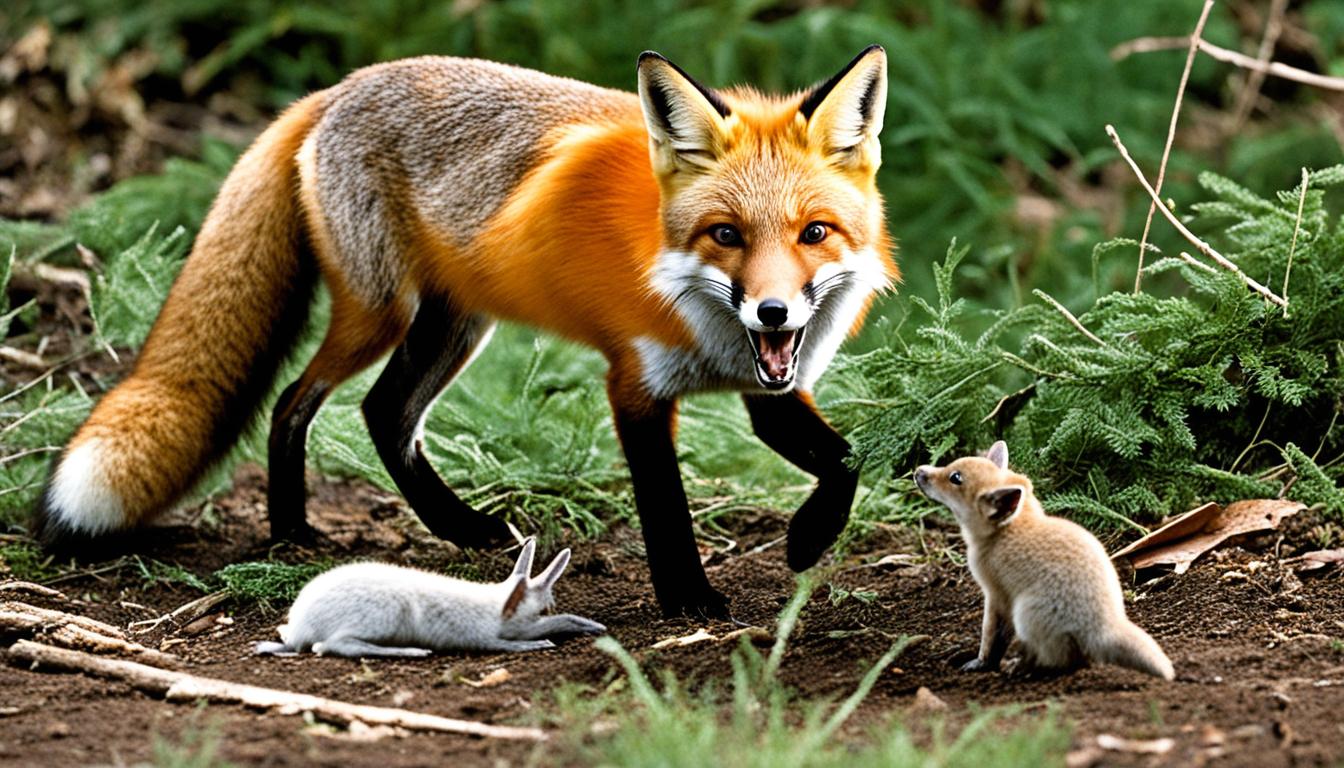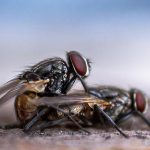Red foxes have a wide-ranging taste when it comes to food. They hunt and scavenge, which means they’re good at finding meals. Their diet mainly consists of small mammals like rodents (rats, mice, voles, and squirrels) and lagomorphs (rabbits and hares).
In the countryside, these animals usually make up about half of what they eat. But, red foxes don’t stop there. They may hunt or find larger or more unusual animals, like hedgehogs and kangaroos. Sometimes, they might even eat human remains. This shows how adaptable they are, surviving in many different places.
Introduction to the Red Fox and Its Dietary Habits
Red foxes are famous for how well they adapt, showing a wide variety in their food choices. They are known for red fox food habits which cover meat-eating but also adding some plants and more. This mix helps them live well in many different places. They eat many things, from tiny mammals and birds to insects.
These foxes eat more than just live animals. They also enjoy fruits and what people throw away. This is important because it means they can find food almost anywhere. No matter if they live deep in the woods or near people in cities, they can eat what’s around them. This skill is crucial for their ability to live and have babies.
Because they eat both plants and animals, red foxes can make a home almost anywhere. They go from catching little animals in nature to finding food in towns and cities. Their meals include birds, bugs, and even some plants or food scraps from humans. Being able to eat many things helps them stay alive in all sorts of places.
Looking at what red foxes eat shows us how smart they are in finding food. Their variety in food means they get all they need to stay healthy and be strong. This makes them great hunters and survivors in the wild.
Primary Prey Items of Red Foxes
Red foxes are great hunters with flexible eating habits. They mainly hunt small mammals. Yet, they also go after birds and bugs. This shows they are skilled at hunting in many different ways.
Small Mammals
Field voles, mice, and rats are a big part of a red fox’s diet, especially in rural areas. The way they hunt these animals proves they are excellent hunters.
Birds
Red foxes also eat birds, including those that nest on the ground. Sometimes, they catch domestic birds too. This shows how clever and flexible they are in finding food.
Insects and Other Invertebrates
In cities, insects and small invertebrates are important food for red foxes. These tiny animals are easy for them to catch. So, cities provide the foxes with plenty of food.
| Prey Type | Common Examples | Hunting Strategy |
|---|---|---|
| Small Mammals | Field voles, Mice, Rats | Stealth and pouncing |
| Birds | Ground-nesting birds, Domestic poultry | Stalking and ambushing |
| Invertebrates | Insects | Quick snatching |
Red Foxes in Different Habitats
Red foxes show us a lot about how they survive by moving around. They can live in many places and change what they eat based on where they are.
Rural Areas
In the countryside, what red foxes eat is mostly what they can find in the wild. They eat animals like mice, voles, rabbits, and hares most of the time. Because there’s a lot of these small animals, red foxes have plenty to eat and don’t need to look for other foods. Sometimes, they catch birds or feed on dead animals, known as carrion, when these are more available.
This shows they’re good hunters and smart about finding food in different ways.
Urban Areas
In the city, life is different for red foxes. There aren’t as many mice and rabbits, so they learn to eat different foods. They end up being omnivores, eating things like insects, leftovers from people, and sometimes birds and mammals. This mix of foods helps them live well even in cities, showing how adaptable and tough they are.
Seasonal Variations in Red Fox Diet
Red foxes change what they eat as the seasons shift. They respond to different prey and weather. These changes help them do well in various places.
Spring and Summer
In spring and summer, red foxes find lots of new food. They can eat many small animals, birds, and fruits. There’s also more greenery, which fits their eating of both meat and plants. Plus, they get to munch on insects and tiny creatures, boosting their diet.
The warm seasons provide a big feast for red foxes. They get to eat lots of small animals like voles and mice. These creatures are an important part of what they eat.
Fall and Winter
But when fall and winter come, some food options go away. Red foxes then start to scavenge more. Their meals include things like dead animals and food people have left behind. They still hunt small animals and birds but don’t find as many fruits and insects. So, they have to look for other foods to stay healthy.
Here is a comparison of red fox diets across different seasons:
| Season | Primary Food Sources | Secondary Food Sources |
|---|---|---|
| Spring | Small mammals, Birds | Fruits, Insects |
| Summer | Birds, Insects | Mammals, Berries |
| Fall | Carrion, Small mammals | Human food waste, Fruits |
| Winter | Carrion, Birds | Human food waste, Scavenged items |
By learning about these diet changes in red foxes, we see something amazing. They adjust what they eat to live through the year. This shows their smart ways to survive with the changing weather and food.
What is the diet of a red fox?
Red foxes eat a mix of meat and plants. They’re great at finding food by hunting and searching for it. This changes depending on what’s available to them in their surroundings.
“Red fox dietary needs extend far beyond just meat; they are omnivorous creatures that seamlessly blend various food sources into their daily intake.”
Because they eat such a variety of foods, red foxes can live in many places. They might hunt for small animals out in the countryside. Or they could be looking for scraps of food in a city park.
| Food Source | Description |
|---|---|
| Small Mammals | This includes things like rats, mice, and rabbits. They eat a lot of this in the countryside. |
| Birds | They also eat birds, like those nesting, and sometimes chickens. This adds to their meat meals. |
| Insects | In cities, they eat insects more. Beetles and grasshoppers are on their menu because they’re easy to find. |
| Fruits and Vegetables | These are a good option when other foods are hard to find. They eat them more at certain times of the year. |
| Human Food Waste | Red foxes in cities find and eat leftover human food. This allows them to live in urban areas easier. |
Their wide food choices show why it’s vital to know what red fox dietary needs and red fox nutrition are. Their diet helps keep the balance in nature. They control the number of animals they eat and help spread plant seeds around.
Red Foxes as Omnivores
Red foxes eat a lot of meat, but they also like some plants. They are able to eat different food, showing how they can live in many places.
Fruits and Vegetables
Red foxes enjoy fruits and vegetables as part of their diet. In the fall, they love berries and apples. These fruits help them get strong for winter. They also eat some veggies when they find them.
Grains and Other Plant Matter
Besides fruits and veggies, red foxes eat grains and plants. They sometimes pick crops like corn, oats, and wheat. This happens a lot in farm areas. Nuts and seeds are good for them too. These foods make sure red foxes stay healthy. It shows how they can live in many places.
Scavenging Behavior of Red Foxes
Red foxes show amazing adaptability by scavenging for food. They are opportunistic and often turn to scavenging, especially in winter or where hunting is hard. You can see this in how they eat carrion, using any food they find to stay alive.
This skill goes beyond just natural food. In cities, they search trash for food people throw away. This is key for them to live in places with little prey or tough climates.
Notably, the red fox’s scavenging helps keep their habitats clean. They eat dead animals and leftovers, acting like natural cleaners. This shows how important they are for the places they live.
Studying how red foxes scavenge tells us a lot about their resilience. Their scavenging ways help them survive tough situations, making them very successful animals in the wild.
Red Foxes and Human Interaction
As cities grow, red foxes and people meet more often. This meeting has taught red foxes new ways to find food. They have adapted well to this change.
Impact of Urbanization
Our cities are now part of the red fox’s world too. They come into our gardens and neighborhoods looking for food. This change means we see them more often.
Adaptation to Human Food Waste
Red foxes are now eating the food we throw away. They have learned to find meals in our trash. This helps them survive as their natural homes disappear.

This change in their diet shows how smart red foxes are. They also play an important role in our cities. They help keep the streets clean of waste and control the number of rats.
| Aspect | Natural Habitat | Urban Environment |
|---|---|---|
| Primary Diet | Rodents, Small Mammals | Human Food Waste, Smaller Mammals |
| Human Interaction | Minimal | High |
| Adaptive Behavior | Hunting | Scavenging |
Learning how red foxes live near us is important. It can teach us how to share our cities better. We can help them by managing our food waste better.
Red Fox Hunting Techniques
Red foxes are smart and sly hunters. They use a mix of sneaking and quick jumping to catch their prey. They know their world well and this helps them hunt effectively. Let’s explore how they do it.
Stalking and Pouncing
A top hunting skill for red foxes is careful stalking and a precise pounce. They silently move making use of bushes or ground cover to stay hidden. When they spot their meal, they pause to check the distance. Then, they jump, grabbing their prey by surprise.
This tactic works best for catching smaller animals like mice and birds. It shows how smart and patient red foxes can be.
Utilizing the Environment
Red foxes are experts at using their surroundings to their advantage. They might hide in trees, under rocks, or even in the city to get close to their prey. Their ability to hunt in a wide variety of places, from forests to cities, shows how adaptable they are.
This adaptability makes red foxes skilled hunters in all sorts of environments.
| Hunting Technique | Description | Common Prey |
|---|---|---|
| Stalking and Pouncing | Careful approach followed by a sudden leap | Rodents, Birds |
| Utilizing the Environment | Using natural or man-made structures for concealment | Insects, Urban Wildlife |
Comparison of Red Fox Diets Across Continents
The red fox adapts well, especially in what it eats. This varies a lot by where they live. Looking at what red foxes eat in North America, Europe, and Australia tells us a lot about their survival skills in different places. It shows how they find food in many ecosystems.
North America
In North America, red foxes eat mostly small mammals like rabbits, mice, and ground squirrels. They also have birds and insects in their meals, plus fruits and berries seasonally. What’s interesting is they adjust their diet based on if they live in the countryside or cities. This shows their amazing ability to live in many different areas.
Europe
In Europe, red foxes also eat a variety of foods. They hunt rodents, birds, and small bugs. In cities, they look for leftover human food, showing how they adjust to living near people. This ability to eat a wide range of foods and switch depending on the environment is a key to their success in Europe.
Australia
Red foxes in Australia have changed their diet to what’s local since being brought over by settlers. They eat local animals like mice, small marsupials, and rabbits. This shows how they are quick to use new food sources. Their diet in Australia is different from other places due to the unique wildlife there.
Comparing what red foxes eat on different continents shows their skill at finding food. It shows they do well in all kinds of environments.
| Continent | Primary Prey Items | Secondary Food Sources |
|---|---|---|
| North America | Rabbits, Mice, Ground Squirrels | Birds, Insects, Fruits |
| Europe | Rodents, Birds, Invertebrates | Human Food Waste |
| Australia | Rodents, Small Marsupials | Rabbits, Fruits |
Impact of Red Fox Diet on Ecosystems
The red fox diet changes how the environment works by what they eat. This is shown in how they interact with other animals and their eating habits. What they eat affects how healthy and stable their homes are.
Role in Controlling Rodent Populations
Red foxes eat animals like rats and voles. This helps keep the number of small animals down. That’s important because too many of these animals can harm farms and spread diseases. So, red foxes are key to keeping nature in balance by eating these pests.
Seed Dispersal
Surprisingly, red foxes don’t just eat meat. They also eat fruits, spreading seeds as they go. This helps new plants grow, adding to the variety of plants in their areas. The fact they eat meat and help plants grow shows how important they are for their environment.
It’s crucial to understand how red foxes impact ecosystems. They show how everything in nature is connected. This highlights their value not just in the wild but also for the circle of life.
Conclusion
The red fox eats a mix of meat and plants, showing how it fits in its surroundings. It eats small animals and birds as well as fruits and what humans throw away. This varied diet helps them live in many places, from the countryside to the city.
Understanding what the red fox eats shows how smart they are. They change what they eat depending on what’s available. This ability to eat different things has helped them do well and spread all over the world. They do important jobs like keeping the number of small animals in check and helping plants spread by eating their fruits.
The red fox does more than just hunt cleverly. Its diet shows how tough and flexible it is. This lets them live in different places and face different challenges. They impress both nature lovers and scientists, showing the complex web of life on Earth.
FAQ
What is the basic diet of a red fox?
Red foxes mainly eat small mammals and lagomorphs, like rats, voles, squirrels, and rabbits. This food group makes up half their diet in the wild. They also eat birds, insects, fruits, and leftovers from human meals.
What are the primary prey items for red foxes?
The main food for red foxes are small mammals, birds, and insects. This includes field voles, mice, and rats. They also catch birds, including nesting kinds and sometimes farm poultry. In cities, they find insects and eat them too.
How does the red fox diet change in different habitats?
In the countryside, red foxes eat mostly local animals like rodents and rabbits. In towns, they add insects, trash, and a bit of birds and mammals to their meals. It shows they can find food in many places.
Do red foxes have seasonal variations in their diet?
Yes, what red foxes eat changes with the seasons. In spring and summer, they enjoy a wide range of foods, like fresh mammals and fruits. But in autumn and winter, they scavenge more because there’s less live prey.
Are red foxes strictly carnivorous?
Red foxes aren’t only meat-eaters. They’re omnivores, so they also eat fruits, veggies, and grains. They love berries, fruits, and nuts in the fall. They’ll eat vegetables and grains if they find them.
Do red foxes exhibit scavenging behavior?
Yes, red foxes often scavenge. They eat dead animals and can find food left by people. This is especially true in winter or when they can’t hunt much. It shows how they make the most of their environment.
How do red foxes interact with humans in urban areas?
With more cities, red foxes have learned to get food from what we throw away. This way, they can still eat even with their homes changing. It fits with their role in nature, even in more urban places.
What hunting techniques do red foxes employ?
Red foxes are smart hunters. They stalk and pounce on their prey. They use their intelligence to catch animals, no matter if it’s in open fields or city blocks.
How does the red fox diet vary across different continents?
Red fox diets change a lot from place to place. In North America, Europe, and Australia, they find food that’s around them. This shows how well they can live in different environments.
What is the ecological impact of the red fox diet?
What red foxes eat helps keep ecosystems healthy by managing the number of rodents. Eating fruits also helps spread plants around. So, they play a big part in keeping nature in balance.










